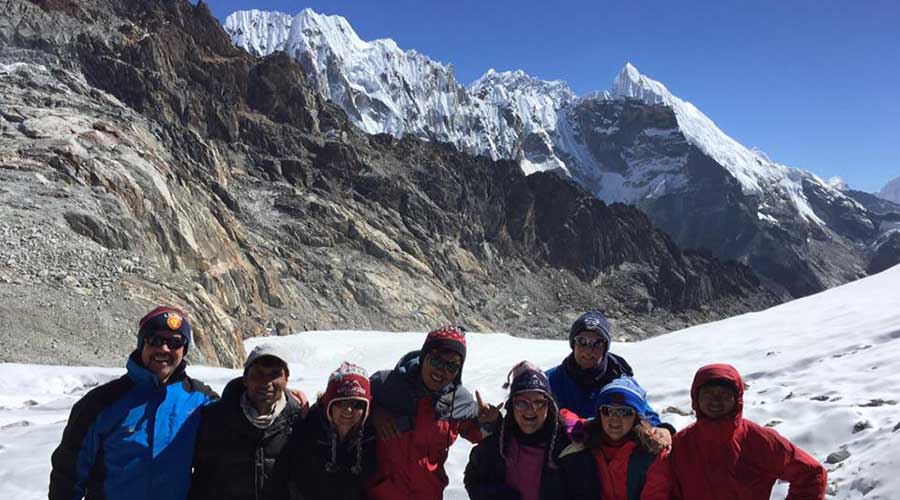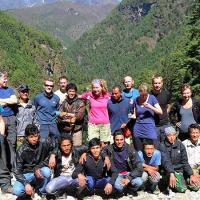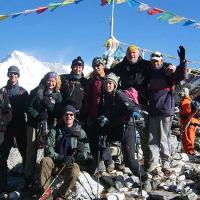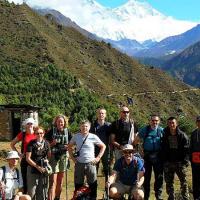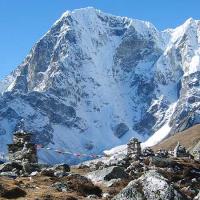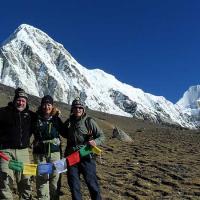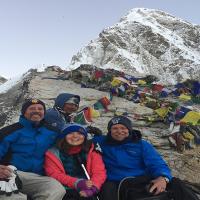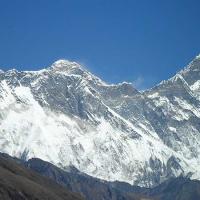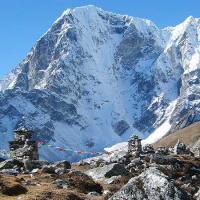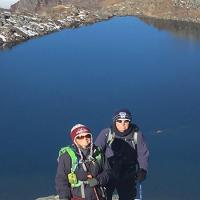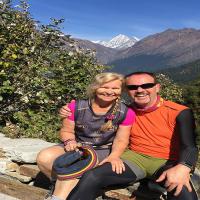

Email Us
contact@destinationhimalayatreks.com
Viber/Whats App 
+977-98510 16814 (Min Gurung)+977-98511 46814 (Tara Rana)
Everest Base Camp Trek
$1249 per Pax
Overview
Everest Base Camp Trekking Everest world’s enigmatic mountain has attracted experienced mountaineers as well as capable climbers over the years to scale the crest of the peak and rewrite history in style. Everest Base Camp Trekking is a historical walk taken towards stepping on the mesmerizing land of the Himalayas. Everest Base Camp Trekking is an eventful journey and an elusive opportunity to walk in the same space shared by legends Sir Edmund Hillary and Sherpa Tenzing Norgay in 1953. The entire trekking circuit is embedded with exotic scenery, glistening snow-capped peaks, spectacular glaciers, legendary Sherpa communities, and their culture along with age-old monasteries.
Everest Base Camp Trekking journey commences from Lukla and steadily leads us towards the magnificent Dudh Koshi River surrounded by an array of rhododendron and magnolia forests, scanty scattered villages, and age-old monasteries. The next day we head towards the interesting location of the busy Namche Bazaar bustling with people immersed and engrossed in their daily chores. A fabulous place to take a stroll and get the feel of the unchanged lifestyles and culture ardently followed till today. Considered a gateway to the Everest Base Camp Trekking we move along we traverse at a steady pace and reach as far as Tengboche renowned for its ancient Buddhist monastery located on the ridge top at 3867 meters belonging to the Khumjung village community also known as Dawa Choling Gompa. The next day dawns and we head chronologically toward Dingboche, Lobuche, and Gorakshep. From here we reach the Everest Base Camp and make a steep ascent towards Kalapatthar (5,550m). An excellent vantage point provides fantastic panoramic views of the entire region. Spending a few thrilling moments we steadily descend getting thrilled by the spectacle of Khumbu icefall we trek back towards Lukla and fly back to Kathmandu.
Destination Himalaya Treks & Expedition takes you on an incredible journey with customized itineraries designed following the climatic variations and interests of the clients as well. Be there to share the glorious moments of history with us.
- Embark on a thrilling flight with picturesque views of mighty Himalayans from Kathmandu to Lukla
- Trek along the mountain landscape and explore the enormous beauty of the surrounding Sagarmatha National Park
- Visit the vintage Tengboche Buddhist Monastery
- Glimpse of the world-famous Khumbu Glacier and Khumbu Icefall in the world’s beautiful mountainous Khumbu valley
- Relish the stunning sunrise view and witness the intense panoramic mountain views of Mt. Everest, Mt. Nuptse, Mt. Lhotse, Mt. Pumori, and Mt. Ama Dablam from Kala Patthar
- Enthralling trekking route, surrounding mountains accompanied by rhododendron forests, terraced fields, meadowland, Buddhist monasteries, wilderness, Sherpa culture, and lifestyle are additional rewards on your trek
Short Itinerary
Day 01: Arrival in Kathmandu (1310m)
Day 02: Fly to Lukla, trek to Phakding (2610m), 3/4 hours walk
Day 03: Trek Phakding to Namche, 4/5 hours walk
Day 04: Rest at Namche (3440m)
Day 05: Namche to Tengboche (3867m), 5/6 hours walk
Day 06: Tengboche to Dingboche (4260m), 5/6 hours walk
Day 07: Dingboche to Lobuche (4930m), 4/5 hours walk
Day 08: Lobuche to Everest Base Camp and return to Gorakshep, 5/6 hours walk
Day 09: Hike to Kalapatthar (5,644m) and then back to Pheriche, 6/7 hours walk
Day 10: Pheriche to Namche bazaar, 5/6 hours walk
Day 11: Namche to Lukla, 5/6 hour walk
Day 12: Lukla to Kathmandu, 40/45 minute flight
Includes
- All required land transportation as per required for trekking
- Hotel in Kathmandu with breakfast
- Domestic flight KTM-Lukla-KTM
- Sightseeing tour in Kathmandu Valley
- Foods and accommodation in trekking
well equipped English speaking guide, necessary - supporting Sherpa or Porters.
- All allowances for supporting crews including their insurance
- Trekkers Information Management System TIMS (Trekking permit), National Park permit or Conservation permit
- Emergency evacuation service if in case needed
- All Official taxes and service charge.
Excludes
- Your personal gears and expenses
- Foods in Kathmandu
- Tip to Nepalese support crews
- Emergency rescue fee if in case
Detail Itinerary
-
Day 01: Arrival in Kathmandu (1310m)
Upon your arrival at the Tribhuvan International airport, the representative of Destination Himalaya treks gives you warm welcome in the adventurous Himalayan country Nepal. Overnight in a hotel.
-
Day 02: Fly to Lukla, trek to Phakding (2610m), 3/4 hours walk
Around 45 minutes flight, early in the morning we take a scenic flight to Tenzing-Hillary Airport, Lukla. From Lukla, we start our trek and head to Phakding. We cross the Chaurikharka village and climb down to Dudh Koshi River and follow the bank of the river in the valley. Unnamed vegetation and seasonal flowers, pine forests, and wild animals with domestic animals will be the major attraction of the trekking trail of Phakding. We finally ascend to Phakding. There we also visit the Monastery. The centuries-old monasteries around Phakding add to the beauty of the village. Overnight in Phakding.
-
Day 03: Trek Phakding to Namche, 4/5 hours walk
Crossing the suspension bridge and walking on the bank of Dudh Koshi will be the usual activity of your trekking. Moreover, your encounter with the Benkar village and the superb views of Mr. Thamserku from Benkar village is really spectacular. The Monjo is the entrance of the world’s highest national park, “The Sagarmatha national park”. Namche bazaar is situated at more high altitude than Sagarmatha national park, it lies at 3440m. In the national park, we can see various flora and fauna. There we can also see various rare wild animals and birds like Red pandas, snow leopards, wild boars, etc. Overnight in Namche.
-
Day 04: Rest at Namche (3440m)
Namche is the first acclimatization place of our trekking. Namche bazaar is famous for many things. Most of the government offices lie in Namche. Furthermore, it is the doorway to the total Everest region. Namche bazaar is surrounded by snowy peaks and mountains, which can be seen from the various hotels stated in Namche. Tourist visitor centers, and long old monasteries, are the attraction of Namche. Email-internet, ATMs, glossary shops, bakeries, and restaurants, are easily available in Namche bazaar. We take a rest at Namche bazaar visiting the surrounding places. Namche is the Sherpa village where we can interact with them and get knowledge of their culture and lifestyle. On this day, we also visit another Sherpa village Khumjung near Namche. There we also visit the Buddhist monastery. Overnight in Namche.
-
Day 05: Namche to Tengboche (3867m), 5/6 hours walk
After one day’s acclimatization in Namche, this day we continue our trek after breakfast. For some time we walk on the plain path to Kenjoma through the forest enjoying the panoramic views of the mountains like Mt. Everest, Ama Dablam, Nuptse, Thamserku, and Lhotse. From Kenjoma we trek down to the small settlement of Phortse Tenga where we take lunch. Then we climb to Tengboche, a Sherpa village with the world’s highest monastery. There we visit the monastery and interact with the Buddhist monks and nuns. From there, we see the excellent panorama of Mt. Everest, Lhotse, Ama Dablam, Nuptse, and Thamserku. Overnight in Tengboche.
-
Day 06: Tengboche to Dingboche (4260m), 5/6 hours walk
Today, we descend downhill to Douche with the scene of uncountable rhododendrons. We cross the suspension bridge that lies over the Imja Khola. We walk through the valley to Pangboche. On the way, we see Mani stone walls. We finally climb up to Dingboche where we stay overnight. Still, you can see the close-up view of Aba Dablam.
-
Day 07: Dingboche to Lobuche (4930m), 4/5 hours walk
From Dingboche, we walk on a gradually ascending path with a view of Mt. Tawache, Nuptse, Ama Dablam as well as Pokalde. We can see Pheriche village from Dingboche. Then, we climb down to Pheriche village and head to Dughla. We cross the bridge on the Khumbu glacier and then we continue walking up a steep hill and finally reach Lobuche. Overnight in Lobuche.
-
Day 08: Lobuche to Everest Base Camp and return to Gorakshep, 5/6 hours walk
This day we achieve our goal of putting our foot on the Everest base camp. From Lobuche, we walk up a rocky moraine path with a view of the Khumbu glacier. Then, we descend to Gorakshep where we take lunch. Then we head to Everest base camp. At Everest base camp, we stay for some time and observe the view of the surrounding mountains including Pumori, Ama Dablam, Nuptse, Lhotse, etc. Then, we return to Gorakshep where we stay overnight.
-
Day 09: Hike to Kalapatthar (5,644m) and then back to Pheriche, 6/7 hours walk
This day in the morning we hike to Kalapatthar to view the panorama of Mt. Everest. Kalapatthar is the perfect vantage point of the Everest region for Mountain View. From there, we observe the panoramic view of Mt. Everest and other mountains of the Everest region like Mt. Lhotse, Mt. Pumori, Mt. Ama Dablam, Mt. Khumbutse, Mt. Nuptse, Mt. Thamserku, etc. Then, we return to Gorakshep. There we take lunch and then back to Pheriche for an overnight stay.
-
Day 10: Pheriche to Namche bazaar, 5/6 hours walk
On this day, we return to Namche bazaar via Tengboche. We walk uphill and downhill through the forest of Rhododendron to Tengboche where we take lunch. From Tengboche, we again descend to Phortse Tenga and then climb to Namche bazaar for an overnight stay.
-
Day 11: Namche to Lukla, 5/6 hour walk
On this day, we descend to Lukla from Namche bazaar following the bank of the Dudh Koshi River. This is the last day of our trek; so we share our experience and enjoy singing and dancing in the evening. Overnight in Lukla.
-
Day 12: Lukla to Kathmandu, 40/45 minute flight
This early in the morning, we fly back to Kathmandu. The rest of the day is free for you to do your own thing. Explore Kathmandu city. Overnight in a hotel.
-
Everest Base Camp Trekking Information
Accommodation
Accommodation in the Himalayas is mostly teahouses or lodges operated by locals. They are comfortable and simple with basic facilities. Extra facilities like hot showers, Wi-Fi, charging of electronic devices, and laundries are available by paying additional charges. Room sharing is common during the peak seasons and at high altitudes. So, prepared for it. Washrooms are mostly outside the teahouse or lodge.
Meals
We provide only breakfast in Kathmandu and 3 meals (breakfast, lunch. dinner) a day are provided during the entire trek. Meals are provided from the teahouses or lodges which is simple but organic and healthy. Nepali Dal Bhat is a chief dish with fresh green vegetable curry. Besides, noodles, soup, bread, roti, Sherpa stew, and hot drinks are also available. You can try continental cuisine at Namche at your own expense.
Drinking Water
Drinking water in the Himalayas is pure and fresh. One can directly drink the natural freshwater stream from the Himalayas. Or fill up the boiled water in a water bottle in the teahouses paying an extra charge. Always carry water purifying solutions for proper water treatment and to be safe. Drink plenty of water and keep yourself hydrated to prevent altitude sickness.
Internet connectivity & Mobile Network
Everest Link’s Wi-Fi card provides internet all over the Everest region. So, internet connectivity is easily available and stable in the lower regions. Mobile Network is also stable in the lower regions. You can also purchase a Sim and use mobile data from it. In higher altitudes, internet connectivity and mobile network are difficult to find.
EBC Trek Starting Point
Lukla is the starting point for any trekking or climbing in the Everest region. From Lukla, pass through the villages of Phakding, Namche, Tengboche, Dingboche, and Lobuche to arrive at Gorakshep. From Gorakshep, trek to the Everest Base Camp and Kalapatthar viewpoint the next day.
"Lukla-Phakding-Namche-Tengboche-Dingboche-Lobuche-EBC-Gorakshep-Kalapatthar-Pheriche-Lukla"
Required Permits
Permits are mandatory in the Himalayas of Nepal. Our required permits are Khumbu Pasang Lhamu Rural Entrance Permit, and Sagarmatha National Park Permit (SNP).
- Khumbu permit costs NPR 2000 (Foreigners), NPR 1000 (SAARC)
- SNP permit costs NPR 3000 (Foreigners), NPR 1500 (SAARC)
Click here to learn more about Trekking Permits.
"DH Treks issues all the required permits for it's clients."Travel Insurance
Travel Insurance is quintessential in the Himalayas. It must cover all emergency evacuation, medical extremities, luggage loss/theft, flight cancellations, altitude above 4000m, etc. Thus, arrange travel insurance from a reputed agency as it is compulsory.
Safety and our guides
We assure you 100% when it comes to safety. Our client’s safety is our main concern. Our guides are certified and well-trained with years of expertise in this field. They are technically competent and have excelled in safety performance. They always carry essential safety equipment, gear, and first-aid kits. For the safety of our trekkers, the itinerary is properly scheduled and acclimatization rest days are properly set up to adjust to the high altitude and prevent altitude sickness. If any queries concerning safety, feel free to share them with our guides. We are always there for your services.
Best time for EBC Trek
The best time to trek is the peak season for safety and to enjoy the spectacular and clear views. Spring and Autumn seasons are the best time followed by the summer season. Winter season is risky and only a few adventurous trekkers dare to climb. We recommend you plan carefully if you want to trek during the off-season.
EBC Trek Difficulty
EBC Trek is full of challenges due to the trek route, and high elevations, but still, it is adventurous. With the proper assistance and guidance of experts, it is achievable. When it comes to EBC Trek, experience in trekking at high altitudes is a bonus. Besides this, trekkers must be in good health, and physically, & mentally fit as it is physically demanding. So, we recommend you participate in exercises, day hikes, and physical training months before starting the trek. Also, take necessary health tests before trekking to high altitudes. You can completely trust our assistance and guidelines throughout the trekking journey.
Altitude Sickness & Acclimatization
Altitude sickness is common in mountains above the altitude of 3000m. The trek starts from Lukla (2866m) and the altitude rises to Kalapatthar (5,550m) during the trek. Namche is the acclimatization resting place to adjust to the altitude and prevent altitude sickness.
Symptoms of Altitude Sickness
Primary: Headache, nausea, gasping, appetite & sleep loss, dizziness, fatigue, vomiting
Extreme: primary symptoms and hallucinations & unconsciousness
Preventive Guidelines
- Immediately inform the guide
- Warm-up, and body stretch before the trekking journey
- Drink water and Hydrate yourself at regular intervals
- Frequent urination throughout the journey
- Ascend slowly and gradually
- Take plenty of rest and sleep
- Avoid salty foods, alcohol, and smoking
- Descend immediately when it’s difficult/uneasy
- Take medicine consulting a guide
Shoes: Trekking shoes, base camp shoes, Rubber sandals
Clothes: Windcheater jacket, Thermals, Down Jacket, Base Layers, Fleece, Long sleeve shirts, Gloves, Towels, Inner garments, Trekking pants, Trousers, Shorts, Socks
Accessories: Sunglasses, Ski Goggles, Hats/Caps, Beanie, Sunscreen, Lip Balm, Head Lamp, Pocket Knife, Personal Hygiene &Toiletries
Sleeping: Mattress, Warm Sleeping bags
Travel Bag: Duffel bag, a day pack, pack cover
Medicine Kit: Wash Kit, First-Aid Kit, Blister Repair Kit, Medicines for preventing Altitude sickness, Prescribed Medicines (Personal use)
Extras: Heat/Leak proof water bottles, Water Purifying solution (Iodine based), Water filters, Insulated cup/flask, Map, Binoculars, Travel Documents, Sewing kit, Cash, Extra batteries, Power bank, Pen, Diary, Book, Reusable (spoon, cup, plate), Reusable bags, Large Waterproof Disposable Bags, Snacks (Choco-bars, Mints, Nuts, Granola Bars)
Note: Customize and rent the above list as a necessity.
